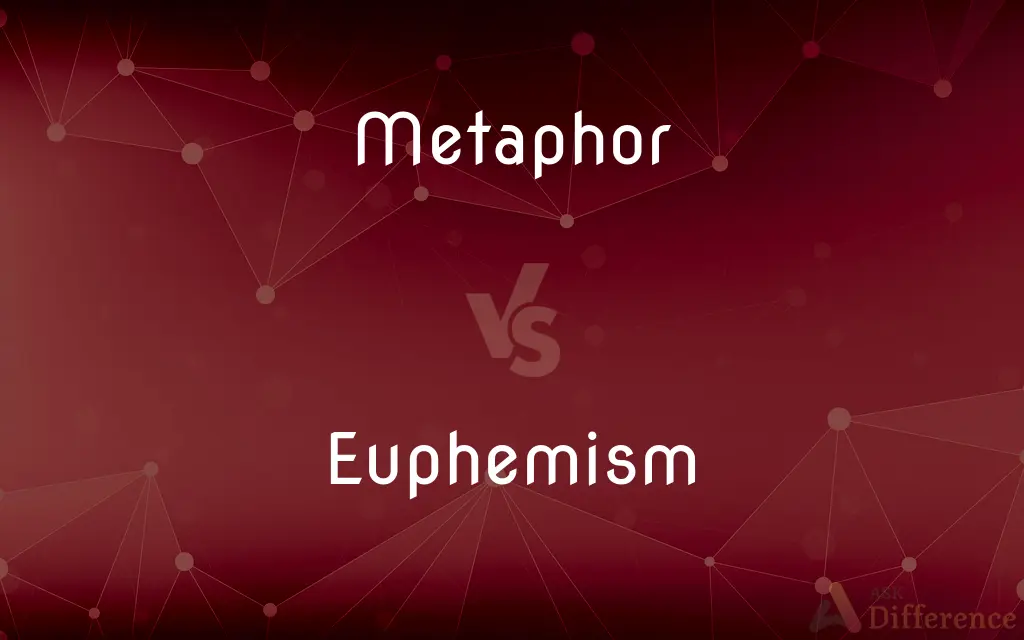Metaphor vs. Euphemism — What's the Difference?
By Tayyaba Rehman & Fiza Rafique — Updated on March 29, 2024
A metaphor is a figure of speech that describes an object or action in a way that isn’t literally true but helps explain an idea, while a euphemism is a polite or mild word or expression used to refer to something embarrassing, taboo, or unpleasant.

Difference Between Metaphor and Euphemism
Table of Contents
ADVERTISEMENT
Key Differences
Metaphors are used in language to create vivid imagery or to express something in terms of another, suggesting a similarity or analogy between them. For example, saying "time is a thief" implies that time steals moments from our lives without stating it directly. Euphemisms, on the other hand, serve to soften or mask the harsh realities, such as using "passed away" instead of "died," making the conversation less direct and potentially less upsetting.
While metaphors are primarily employed for their expressive power and creativity, enhancing both written and spoken communication, euphemisms are utilized for sensitivity, politeness, or to adhere to social and cultural norms. This distinction highlights the metaphor's role in enriching language with imaginative comparisons and the euphemism's function in navigating social interactions more gracefully.
Metaphors enable writers and speakers to convey complex ideas and emotions in a concise and impactful way, often invoking deep thought or a new perspective in the audience. Euphemisms, however, are often employed to avoid discomfort, addressing topics like death, bodily functions, and other sensitive subjects in a way that is deemed more acceptable or less direct.
The use of metaphor is a hallmark of creative language, found extensively in literature, poetry, and everyday speech, celebrated for its ability to draw connections between seemingly unrelated concepts. Euphemisms, while also common in daily language, are particularly prevalent in contexts requiring tact, such as formal discussions, healthcare, and situations involving social delicacies.
Despite their differences, both metaphors and euphemisms enrich language, the former by adding layers of meaning and the latter by facilitating smoother, more considerate communication. They illustrate the versatility and adaptability of language in expressing the full spectrum of human experience.
ADVERTISEMENT
Comparison Chart
Definition
A figure of speech that implies a comparison.
A mild or indirect word substituted for one considered harsh or blunt.
Purpose
To create vivid imagery or express ideas creatively.
To soften the impact of the expressions of uncomfortable subjects.
Usage Context
Literature, poetry, everyday language.
Social interactions, formal discussions, sensitive subjects.
Example
"Time is a thief."
"Passed away" instead of "died."
Impact on Communication
Enhances creativity and depth.
Promotes social tact and sensitivity.
Compare with Definitions
Metaphor
A tool for adding emotional intensity or depth.
Hope is a beacon in the night.
Euphemism
A mild or indirect term used to replace a harsh, blunt, or offensive one.
She is between jobs instead of unemployed.
Metaphor
A comparison not using "like" or "as" to suggest similarity.
The world is a stage, and we are merely players.
Euphemism
Employed to avoid causing offense or to address taboo subjects.
They are economically disadvantaged instead of poor.
Metaphor
Used to describe an action or attribute in terms of something else.
He drowned in a sea of grief.
Euphemism
Can be used in professional settings to soften messages.
The company is downsizing instead of the company is firing employees.
Metaphor
Invokes imagination or creative thought in the listener or reader.
Life is a rollercoaster, full of ups and downs.
Euphemism
Often used to discuss illness, or other sensitive topics.
He passed away instead of he died.
Metaphor
Employed to convey complex concepts in an accessible manner.
Her words were a knife cutting through the silence.
Euphemism
Facilitates more palatable or socially acceptable conversations.
He has a colorful history instead of he has been in jail.
Metaphor
A metaphor is a figure of speech that, for rhetorical effect, directly refers to one thing by mentioning another. It may provide (or obscure) clarity or identify hidden similarities between two different ideas.
Euphemism
Euphemism () is an innocuous word or expression used in place of one that may be found offensive or suggest something unpleasant. Some euphemisms are intended to amuse, while others use bland, inoffensive terms for concepts that the user wishes to downplay.
Metaphor
A figure of speech in which a word or phrase is applied to an object or action to which it is not literally applicable
Her poetry depends on suggestion and metaphor
When we speak of gene maps and gene mapping, we use a cartographic metaphor
Euphemism
A mild, indirect, or vague term for one that is considered harsh, blunt, or offensive
"Euphemisms such as 'slumber room' ... abound in the funeral business" (Jessica Mitford).
Metaphor
A figure of speech in which a word or phrase that ordinarily designates one thing is used to designate another, thus making an implicit comparison, as in "a sea of troubles" or "All the world's a stage" (Shakespeare).
Euphemism
The use of such terms
"Euphemism is common in hospital and medical facilities where bodily functions need to be discussed" (Diane F. Halpern).
Metaphor
One thing conceived as representing another; a symbol
"Hollywood has always been an irresistible, prefabricated metaphor for the crass, the materialistic, the shallow, and the craven" (Neal Gabler).
Euphemism
(uncountable) The use of a word or phrase to replace another with one that is considered less offensive, blunt or vulgar than the word or phrase which it replaces.
Metaphor
The use of a word or phrase to refer to something other than its literal meaning, invoking an implicit similarity between the thing described and what is denoted by the word or phrase.
Euphemism
(countable) A word or phrase that is used to replace another in this way.
Metaphor
A word or phrase used in such implied comparison.
Euphemism
A figure in which a harsh or indelicate word or expression is softened; a way of describing an offensive thing by an inoffensive expression; a mild name for something disagreeable.
Metaphor
The use of an everyday object or concept to represent an underlying facet of the computer and thus aid users in performing tasks.
Desktop metaphor; wastebasket metaphor
Euphemism
An inoffensive expression that is substituted for one that is considered offensive
Metaphor
(intransitive) To use a metaphor.
Metaphor
(transitive) To describe by means of a metaphor.
Metaphor
The transference of the relation between one set of objects to another set for the purpose of brief explanation; a compressed simile; e. g., the ship plows the sea.
Metaphor
A figure of speech in which an expression is used to refer to something that it does not literally denote in order to suggest a similarity
Common Curiosities
What is a euphemism?
A euphemism is a polite or mild phrase used to replace harsher, blunter, or more offensive terms.
How do metaphors affect communication?
Metaphors enrich communication by adding depth, creativity, and clarity to descriptions and ideas.
How do euphemisms affect communication?
Euphemisms can make communication more palatable or acceptable, especially in sensitive contexts, but may also obscure the truth.
Can metaphors and euphemisms overlap?
While they serve different purposes, in some contexts, metaphors can act as euphemisms by indirectly describing sensitive topics.
Example of a euphemism for death?
"Passed away" is a common euphemism for "died."
Can euphemisms be misleading?
Yes, overuse or inappropriate use of euphemisms can obscure the truth and mislead listeners or readers.
Why use a metaphor?
Metaphors are used to enhance language and communication by drawing creative and insightful comparisons.
Example of a metaphor in literature?
"All the world's a stage, and all the men and women merely players..." from Shakespeare's "As You Like It."
How do cultures affect the use of euphemisms?
Cultural norms and values significantly influence what is considered sensitive or taboo, thus affecting the use of euphemisms.
Can the use of metaphors enhance learning?
Yes, metaphors can make complex or unfamiliar concepts more relatable and easier to understand.
What is a metaphor?
A metaphor is a figure of speech that directly compares two unlike things, suggesting they are alike in a significant way.
Why use a euphemism?
Euphemisms are used to avoid offending or discomforting by softening the discussion of sensitive or unpleasant topics.
Can a metaphor be a euphemism?
Yes, when a metaphor softens the impact of discussing a sensitive subject, it functions as a euphemism.
Are euphemisms always appropriate?
While often intended to be polite or sensitive, euphemisms may not always be appropriate, especially if clarity is essential.
Are metaphors only used in poetry?
No, metaphors are used across all forms of language, including everyday speech, to convey ideas vividly.
Share Your Discovery

Previous Comparison
Extremely vs. Rude
Next Comparison
Volume vs. LitreAuthor Spotlight
Written by
Tayyaba RehmanTayyaba Rehman is a distinguished writer, currently serving as a primary contributor to askdifference.com. As a researcher in semantics and etymology, Tayyaba's passion for the complexity of languages and their distinctions has found a perfect home on the platform. Tayyaba delves into the intricacies of language, distinguishing between commonly confused words and phrases, thereby providing clarity for readers worldwide.
Co-written by
Fiza RafiqueFiza Rafique is a skilled content writer at AskDifference.com, where she meticulously refines and enhances written pieces. Drawing from her vast editorial expertise, Fiza ensures clarity, accuracy, and precision in every article. Passionate about language, she continually seeks to elevate the quality of content for readers worldwide.















































